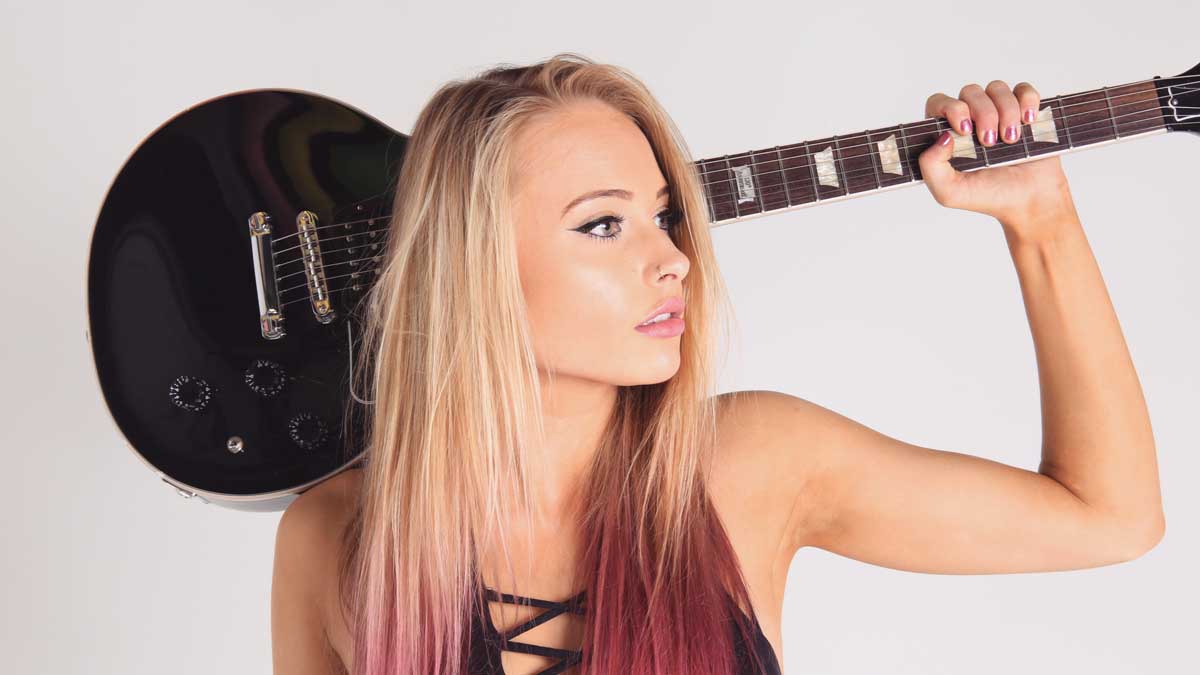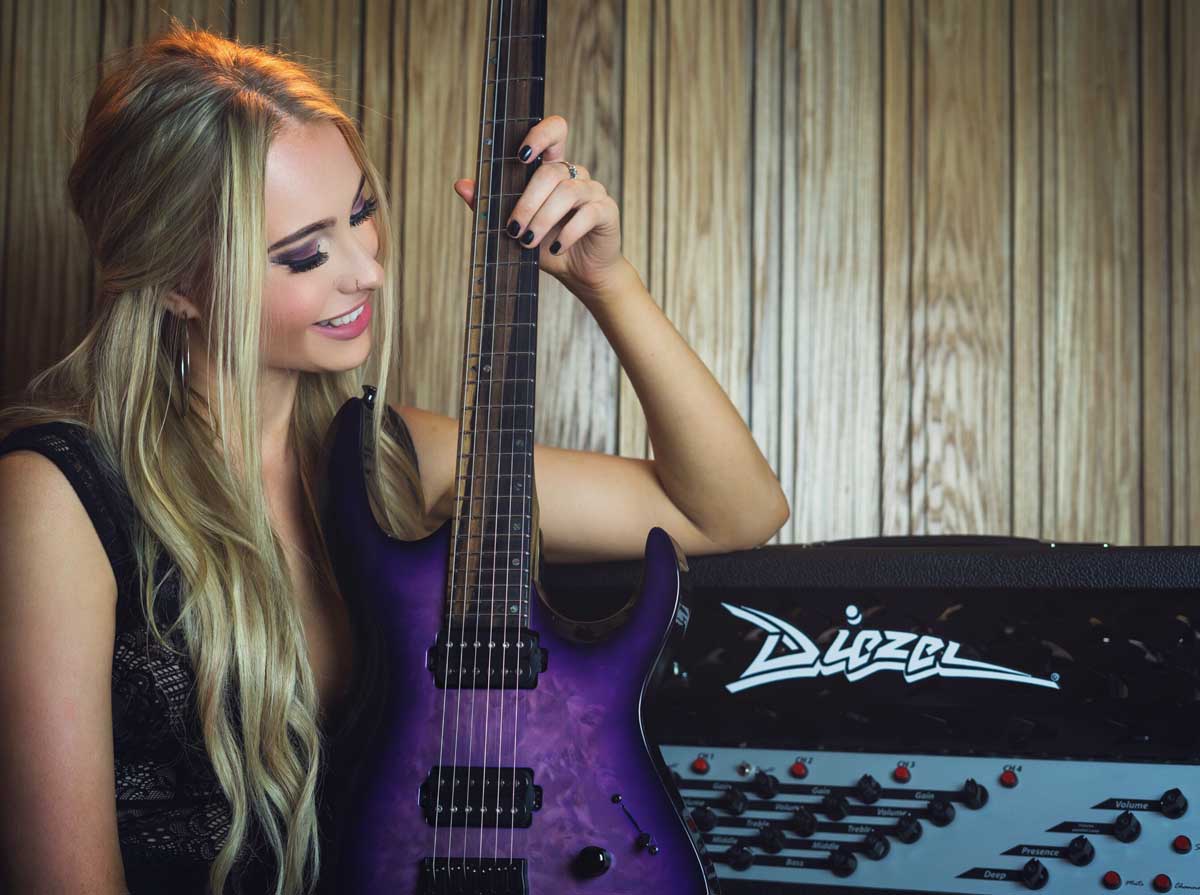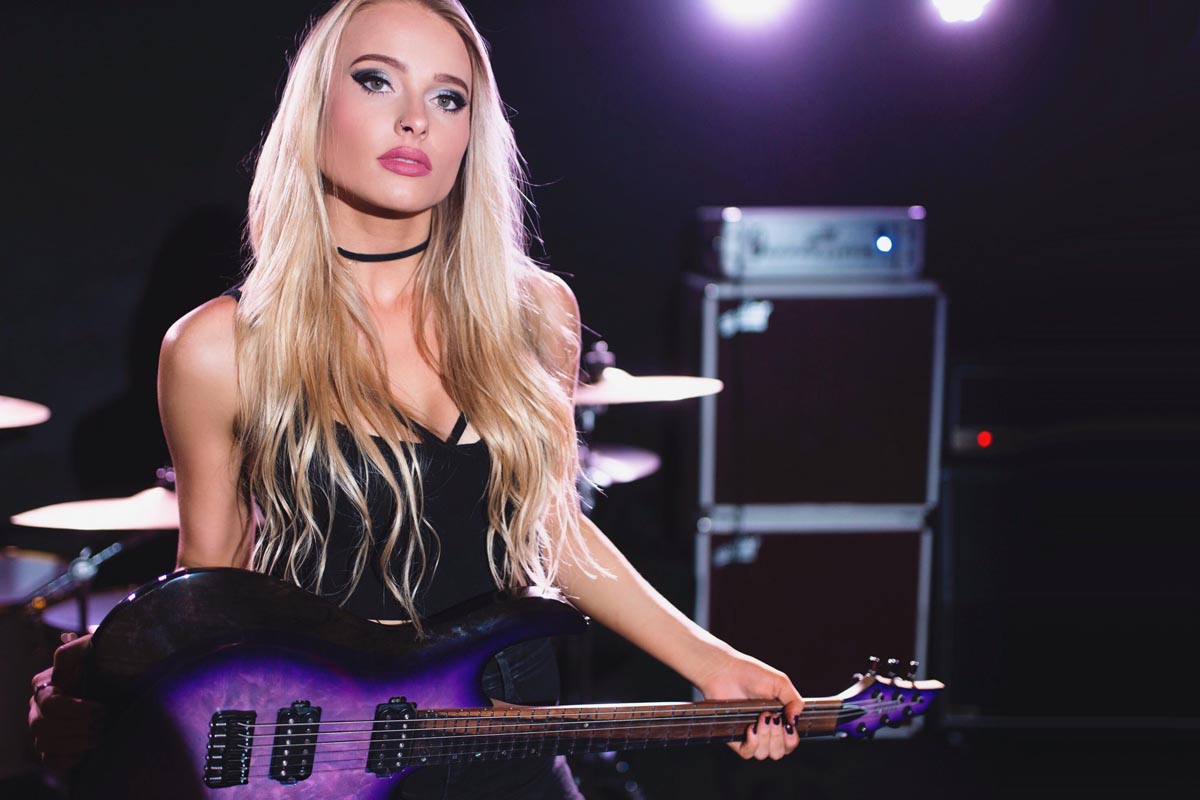Sophie Lloyd: “Trolls got me down, so I made a ‘shredding to Justin Bieber‘ video as a retort. You can shred over anything you want!”
The six-string social media phenom talks online shredding, her love of high-gain guitar tones and her approach to breaking down the classics

It’s kind of strange seeing Sophie Lloyd in the 16:9 aspect ratio of a Zoom meeting. We’re far more used to seeing the English guitarist in a boxy, Instagram-friendly 1:1.
But it’s definitely Lloyd. That's her trademark Diezel VH4 sitting the background. More on why she chose this four-channel monster as her go-to guitar amp shortly. Beside the VH4 is a newly acquired signature guitar custom-spec’d with Kiesel, which is as good a reason as any for the call.
From the sharp angles of its 3x3 pointed headstock – complete with drop shadow Kiesel logo – to its hardtail Hipshot bridge, the Sophie Lloyd Limited Artist Edition A6H is a shredder’s guitar.
The Kiesel has a tight low end and it can sustain for ages. It’s everything I wanted out of a tone
Lloyd’s A6H has a black limba body with a burl maple top, a bolt-on neck, and a royal ebony fingerboard that’s carved into a flat ’n’ speedy 14” radius and topped with 24 stainless steel medium-jumbo frets.
Her signature Purple Burst finish showcases all the detail in the burl. There are a couple of direct-mount Lithium humbuckers, a five-way blade selector with volume and tone controls. As Lloyd says, one of the big attractions of the Kiesel is that the guitars are customizable, but for them to work with her sound, they have to be versatile, too.
Educated at the UK’s BIMM Institute, Lloyd has built a formidable 350k+ following on Instagram through her uncanny talent for plucking classic tracks from the pop-cultural canon and reimagining them as instrumental shred pieces.
She will take on anything. It could be a John Williams piece, such as the Jurassic Park theme, Guns N’ Roses’ November Rain or the Eagles’ Hotel California, but Lloyd pares the composition down, rebuilds it as a guitar piece and makes it her own.
Get The Pick Newsletter
All the latest guitar news, interviews, lessons, reviews, deals and more, direct to your inbox!
Here we will talk about that process, and what that demands of her technically. But we'll also talk about what it is like to be the quintessential 21st century guitar hero – one who developed her sound and grew her audience almost entirely online.
The internet offers today’s player incredible advantages in getting their music out, but it's not without its downsides. Not least of which is the question of trolls, but also is it incentivizing behaviors that are unhealthy for musicians?
But let’s start with the Kiesel. Because it's way too cool not to.

What drew you to Kiesel?
“I’ve known a lot of people online who I follow and am close with who have played a Kiesel before. Rob Caggiano from Volbeat first introduced me to them. I looked them up and they have a nice online community around them; everyone seems to be very, very supportive of each other, and everybody is involved with each other’s stuff.
“The great thing about Kiesel is that they are quite customizable. If you give them a call they will kind of do whatever you want with it, which is really, really cool for a guitar brand, and I think that is what makes them unique, just how personalized you can get your instrument.”
Is yours an off-the-shelf body shape?
“This is the Aries model. It came with everything I wanted. It’s got that shreddy shape that you’d get with an Ibanez, with the heel-cut, but it has the warm, rounded tone of a Les Paul type of guitar, which is perfect for me because I had a Les Paul before this and I loved the tone. I just wanted something that would lend itself towards fast playing and a full 24 frets.”
What pickups are in it?
“These are the Kiesel Lithium passive pickups. They have a really, really great balance between power and clarity. They are very versatile, so if you are playing that lead stuff, or even more chordal stuff, like jazz – I did a jazz model at uni with this guitar and they said the tones were great. It has a tight low end and it can sustain for ages as well. It’s everything I wanted out of a tone.”
You use a string dampener. What benefits do you get from it? Is there an impact on the tone?
“No, it doesn’t at all. Some people say it is cheating. I probably agree. I started using it when I first got into the studio because I think whenever you are recording it is almost essential to use one to get rid of that excess string noise and palm noise. It acts as a mute if you were to do some two-handed tapping. It doesn’t affect the tone at all.”
Behind you, there is a VH4. Now, our first question would be: do you only endorse gear that rhymes with weasel?
“Yes! That is the main thing.”
We await you joining Dweezil Zappa’s touring group. But in all seriousness, how do you tame that VH4 in a domestic setting? Do you use an attenuator?
“Sometimes I’ll mic this up, but because I'm in a London flat, I’ll use the Neural DSP Archetype [plugin]. I use a lot of guitar software, and they’re great; they emulate the Diezel tones.”
Ah, so when you do a segment for social media, you won’t necessarily go through the amp?
“Yeah, I’ll be going through my audio interface. It depends what I'm doing. Sometimes I’ll mic up the Diezel if it's a bigger shred, like Living On A Prayer, when I did my shred version on YouTube, or on playthroughs of my own stuff. Then I’ll go through the Diezel because I want it to sound big and fat. But the smaller posts I’ll use the Neural DSP.”
The VH4 is fascinating. It’s just so much… amplifier. Talk us through some of its features. How does it work with your playing?
“I started using this amp when I went into the studio to record my first EP, Delusions. The producer [Jason Wilson] had it, and he just got the best tone I have ever heard out of my guitar. I literally heard it and went, ‘This is it. This is the tone. What is it?’
“I think he had run it through two cabs, a Marshall and an Orange. There was a lot of production going on as well. I absolutely loved it, and I actually got into a band with that producer – he let me steal his and we went on tour with it.
“Every night it would just sound great, and I would listen back on the videos, and when you listen back on live performances [usually] it’s like, ‘Oh, it doesn’t sound as good as I thought it did.’ But every time, ‘Yup! That’s the tone.’ It’s interesting, because it doesn’t have any of the normal features; it doesn’t have reverb built in or anything like that.
“But out of the back it has four channel loops, so each channel has a separate effects loop, which was really good because I could have my delay and reverb set on the Lead channel, and all I needed to do was switch to that channel and it would be there. And on the Clean channel, I could have a chorus and a phaser.”

Is it a more subtle amplifier than its reputation would suggest?
“I think so. I think the clean tones you can get out of it are really beautiful, because the clean tones on some amps, I find they can be a little bit distorted, like with Marshall amps, I find their cleans break up just a little bit, which is a cool sound but it is not the sound that I want.
“But these are really clean. Channel two is a crunch channel, so it’s a lot more bluesy, and you have full control of how much gain you want. I am a sucker for channel four, though! The big leads channel, that’s the channel we all want to be on.”
What other amps do you use?
“I have a 100-watt Boss Katana, which is a really good practice amp. I use that every day, because you can have it quiet and still get really great tones. Everything is built-in. It’s kind of the reverse of the Diezel; you don’t need any pedals. I also recently got the Boss GT-1000.”
Nice. How do you find the GT-1000 as an amp modeler? It can do so much...
“I absolutely love it so far. Obviously, I haven’t had the opportunity to play it live yet and test those cool features, but you can just plug it in front of house at a gig and you don’t actually need an amp.
You need to go into music school with the mindset of knowing who you are as a musician, because generally at music school they will try and shape you
“I think that’s what Nita Strauss does. At the football games she plays, she uses one. I am really excited to try that out. At the moment, I use it plugged in when I am practicing, just to get some cool tones.
“It is amazing just how many built-in tones are great just as they are – I haven’t experimented too much on my own because they stuff that they give you is just beautiful straight out of the box. It has got stuff for jazz, stuff for rock, metal, everything you could want.“
You mentioned tones at university. Did they grade you on tone at BIMM?
“It was part of it. It definitely wasn’t like you would fail if you had an awful tone, but it could boost you up a few marks. When I was at BIMM, I didn’t get into tone that much.
“I wasn’t a super-super gear head. I’ve got a lot more into tones recently, and that’s why I like the GT-1000 so much because it means I can experiment when I am writing. I can just hit a button and it is a crazy octaver that I would never think to use, but then you write a cool part with it.”
The GT-1000 would have been very handy at BIMM.
“Yeah, if I had had this as a student I would have literally have taken it in everyday, especially since it is so small. You can carry it on the tube. When we were there, at music school, when you are doing the live performances, it’s kind of like everyone has the same tone. The amps are there and you can’t really touch anything a lot of the time.”
How did you find music school? Was it a collegiate environment, collaborative, or was it competitive?
“I think it’s a mix of everything. I don’t think it is for everyone. You need to go into music school with the mindset of knowing who you are as a musician, because generally at music school they will try and shape you into a certain thing.
“In my experience, they wanted everyone to become a session player, so if you knew you wanted to be a rock guitarist, like I did, they wouldn’t really let you be a rock guitarist. They would be like, ‘Well, you need to do all of this stuff, and you need to learn this.’ Looking back, I think that was very beneficial, because learning all of these country licks and jazz licks, I can now put them into my playing. I’m very glad I did learn them.
“But the way they go about it, the general vibe of music school, if you didn’t want to be a session player, it wasn’t really worth doing. They didn’t encourage you to be your own artist.”
Could you be a session player now?
“I think I could. I don’t mind being a session player but I definitely think my skills cater a lot more to the rock/shreddy type of stuff and I think, as a session player, you have got to be really good at all the genres. I can’t do the chicken pickin’ so I couldn’t do the country sessions. But I have done the odd session here and there. [Pauses]
“But I am so happy with what I am playing now. I get invited as a session musician but I get invited as myself. ‘Now, we want a Sophie Lloyd solo.’ I get to do it that way, which I think is a lot of fun, rather than trying to emulate what other musicians have sounded like.”

How do you take apart a song when you are going to do a cover? Because it always sounds like you and yet these songs are so stylistically diverse.
“I just did a vlog about this on my Patreon. I will listen to the piece, find out what the basic chords are, and then getting the tones is a big part. I’ll whack some distortion on there, double-tracked, panned to both sides, and have my usual rhythm with an octave on top.
“I like to continue that across all the different shreds that I do so that they sound relatively even – even though they are completely different songs, different genres, just so they have a consistent path through them. And it’s the same thing with the leads. I am experimenting a bit more with them.
You want to hit the key notes in your melody that people will recognize… And then… Then just do stupid stuff around that!
“Then, I’ll try get the melody down. I’ll figure out what the melody is, and once I know what it is and I can play that fluently, I will make it a bit more guitar-y, adding some bends and some slides, and once I have got that going I’ll say, ‘Okay, there are breaks here and here; let’s put some super-fast lick in there but make sure that we land on that ending melody so it stays within that melody.’
“It is thinking about your target notes. You want to hit the key notes in your melody that people will recognize… And then… Then just do stupid stuff around that! [Laughs]”
Totally. That's the thing with instrumental guitar – you need to know where that off-ramp is.
“Definitely. It is knowing where you want to go with it. I am quite a methodical writer. I think it is one of my biggest weaknesses, but also one of my biggest strengths. I find it very challenging to just put on a back track and think, ‘Oh yeah, here we go!’ And then just shred something.
I came from quite a small town. There was no music scene. They didn’t have gigs at all where I was from. It was unheard of to be a musician, and online is where I found my community
“I find that quite challenging. I like that proper nerdy thing – sit down with headphones and try and write the piece mathematically, in a way. ‘Play this here. I’ll play this there. And then I’ll wanna do a shredding part here.’ I’ll really think it through and process it, and once I have written it, then it’s, ‘Okay, now I have to learn how to play this.’
“I think it’s a strength because it has really given me my particular sound, and how I play, but I would also love to be able to practice more improvising, and be a little more ‘Let’s go!’ and play a crazy solo.”
That is the eternal – and internal – struggle for musicians. Every player’s greatest strength is the fact that they are themselves, unique.
“Yeah, definitely.”
And then it’s also our greatest weakness, because we always covet another person’s abillity, or way of phrasing something…
“Yeah, we’ll never be satisfied!”
But getting past all that, it’s healthy and mature to make peace with what we are not great at and look at the wider picture.
“Before I probably wouldn’t even have admitted that I couldn’t improvise that well. I wouldn’t have even said that. But I think playing like I do, makes me who I am as a guitar player, and I love it. I hate it a little bit, but I love it. I’m still figuring it out. I am still a young musician in the grand scheme of things. I am still learning. I’m still processing everything.”
Okay, that’s the guitar. But how do you survive the internet? It’s like playing to an audience where the hecklers are in your monitors.
“[Laughs] Oh, 100 per cent.”
More fundamentally, though, social media rewards certain behaviors, and is metrics-driven, and yet here you are, a musician, unique. How do you work through all that, resisting the algorithm to be yourself?
“Well, the internet is amazing. It got me where I am today. I am a glorified bedroom player in a way. All of my videos have been online, and that is definitely where I have become well known in the guitar world. And I think that is really, really cool.
“I have met so many people, people I wouldn’t have known otherwise, so many friends I wouldn’t have made if it wasn’t for the internet and being in that guitar community – especially since I came from quite a small town. There was no music scene. They didn’t have gigs at all where I was from. It was unheard of to be a musician, and online is where I found my community.
“I’ll always be thankful for that but it is quite difficult with trolls. I think if you are putting something out on the internet, you have got to have a thick skin. You’ve got to think, ‘Yeah, I am going to get some negative comments. People are going to be rude about this. You’re going to be made into a meme at some point.’ All this stuff is going to happen and you are just going to have to brush it off.”
That takes some doing.
“It is really, really hard. I remember my Nirvana shred cover, which was Smells Like Teen Spirit, I took it as fun. I was jamming over a cool, well-known song and then everyone in the comments – I don’t want to blast anyone but it was shared on this Facebook page. It was crazy. ‘Kill yourself!’ All of this. ‘Kurt Cobain would shoot you!’
“It was horrible. It was dark. That got me down for a few days, but that is when I got this epiphany where, ’I am on the internet, and I have to just deal with this.’ The next day I made a ‘shredding to Justin Bieber video‘ instead. It was a retort. You can shred over anything you want.”
Although the internet is great for guitarists, and you can find so much great, emerging talent, it is also quite dangerous for making people not feel good enough, and have this mental health struggle
That is not healthy.
“My worry is that people who have just started guitar will see these comments, or see the things that people are saying, and then they won’t want to carry on playing because they might feel, ‘I’m not playing it right. I don’t want to get hate like that.’
“It might really put them off playing. Although the internet is great for guitarists, and you can find so much great, emerging talent, it is also quite dangerous for making people not feel good enough, and have this mental health struggle.”
- The biggest threat to the guitar? It could well be guitarists: how online hate endangers the instrument we love
- Why comparing yourself to other guitarists is bad news for your playing, creativity and mental health

What are your plans now? You have an album in the works.
“I have indeed. We are almost finished getting all the demos together so we are hoping to go into the studio with Romesh [Dodangoda] around March. I am really excited for this album because it is going to be quite a collaborative album.
“We’re getting a lot of vocalists onboard. Obviously, I am mainly an instrumental player, but this album is going to have a lot of guest vocalists, and I think will be really, really fun to write in that way.
“I really enjoyed that process, because each song on the album is quite different. They all cater to specific vocals to specific styles of the people who we want to sing on it. It has been really fun to write in that way.”
What can we expect? Are they all original compositions?
“Yeah, all original. There are probably going to be three instrumentals that are little more old-school Sophie-style and then there is a lot of rock, classic rock ’n’ roll, a lot of blues-rock and there’s some slightly heavier proggy stuff as well. There’s a pop-punk song as well, which is happy and poppy.
“It depends on what singers we get on it. We want it to be an album that people look at and think, ‘That’s so weird… But it works.’ It has a consistent theme throughout but everything is different. It’s inspired by Slash’s R&FN'R, that first album he did with Lemmy, Fergie, and all those people.”
Jonathan Horsley has been writing about guitars since 2005, playing them since 1990, and regularly contributes to publications including Guitar World, MusicRadar and Total Guitar. He uses Jazz III nylon picks, 10s during the week, 9s at the weekend, and shamefully still struggles with rhythm figure one of Van Halen’s Panama.
“I was in a frenzy about it being trapped and burnt up. I knew I'd never be able to replace it”: After being pulled from the wreckage of a car crash, John Sykes ran back to his burning vehicle to save his beloved '76 Les Paul
“His songs are timeless, you can’t tell if they were written in the 1400s or now”: Michael Hurley, guitarist and singer/songwriter known as the ‘Godfather of freak folk,’ dies at 83










